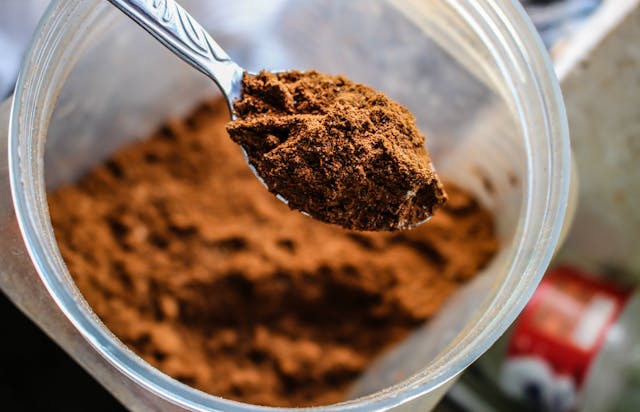Protein powder has become an indispensable supplement for anyone looking to accelerate fitness goals like building strength or improving athletic performance. Packed with essential amino acids, protein supplements help enhance workout recovery, increase lean muscle growth, aid weight control, and provide a convenient nutritional boost.
With a dizzying array of formulations flooding the market, choosing the ideal protein can prove challenging between popular options like whey, plant-based blends, and egg white powder. This comprehensive guide covers everything related to protein supplements—their composition, benefits to users, criteria for selecting the best match, proper usage tips, and dose timing for maximum results.
What Is Protein Powder?
Protein powder refers to concentrated protein from animal or plant foods processed into a fine powder meant to be reconstituted and consumed as a beverage or added to foods. Manufacturers commonly derive supplemental protein from sources like:
- Milk – Used to produce popular whey and casein powders
- Eggs – Egg white protein isolates
- Plants – Pea, soy, rice, hemp, etc
While whole foods also contain protein, supplements provide it in far more concentrated amounts without extra carbs, sugars, or fat, making supplements convenient nutrition for fitness buffs and athletes.
Understanding Protein Powder Ingredients
While protein remains the star component, most commercial powder blends contain additional ingredients for flavor, texture, shelf stability, etc:
- Sweeteners: Sugars like sucralose, stevia, or monk fruit add flavor, helping the naturally bland purified protein dissolve more easily. Products marketed as sugar-free use non-nutritive sweeteners.
- Thickeners: Gums like xanthan and guar thicken liquids to make shakes creamier and more indulgent-tasting. They also stabilize separates between scoops.
- Artificial Flavors and Colors: Ingredients imparting chocolate, vanilla, or fruity flavors enhance palatability especially for daily consumption. Artificial dyes provide vibrant, appetizing hues.
- Fats and Carbohydrates: While protein dominates, some blends add MCT oil powders, nut butters, or low-glycemic carbs to support athletic performance and recovery.
When assessing products, evaluate what’s alongside the protein based on preferences and diet. Many natural, minimally processed options exist, too.
Benefits of Protein Powder
Supplemental protein intake primarily aids athletic individuals, but benefits extend to general wellness, too:
- Increased Muscle Growth and Repair: Protein provides amino acid building blocks to boost recovery, maximize workout benefits, and spur the development of stronger, larger muscles over time.
- Enhanced Recovery: Protein speeds up exercise recovery, helping amateur and pro athletes train harder and minimize post-workout soreness through accelerated muscle repair.
- Weight Management: High protein intake is linked to lowered body fat percentages. Protein enhances satiety and diet compliance, aiding sustainable weight loss for many dieters.
- Improved Bone Health: Adequate protein prevents bone mineral loss, especially among mature adults, aiding the mitigation of osteoporosis and the risk of fractures.
- Boosted Immunity: Protein helps synthesize antibodies and enzymes central to proper immune function. Deficiencies are linked to increased illness and infection susceptibility.

Types Of Protein Powder
With a staggering variety available, narrowing choices down can get overwhelming. Here’s a primer on common supplemental proteins:
- Whey Protein: The most popular choice derived from milk during cheese production. Contains all essential amino acids needed by humans. Fast-absorbing, making it ideal for workouts.
- Casein Protein: Also dairy-derived, casein digests slower, making it suitable for sustained nutrition between meals. Less insulin spike than whey.
- Soy Protein is made from processed soybeans. It is rich in amino acids comparable to animal proteins. It also packs fiber, vitamins, and minerals. Avoid if allergic.
- Pea Protein: This vegan-friendly choice is extracted from yellow split peas. It has an impressive amino acid profile but is lower in certain muscle-building compounds than, say, whey. Still, it is great for most vegetarians and vegans.
- Rice Protein: A plant-based option sourced from milled rice. Hypoallergenic, although relatively low in the essential amino acid lysine. Often blended with pea protein to improve amino balance.
- Hemp Protein: Made by cold-pressing hemp seeds. Provides high fiber assisting digestive and heart health on top of protein. Has omega fats, vitamin E, magnesium, etc too.
Choosing The Right Protein Powder
With endless formulations available, selecting one aligning with individual needs requires assessing the following:
- Dietary Needs: Choose vegetarian/vegan sources like pea and rice protein if following plant-based diets. Ensure dairy-free if lactose intolerant. Verify no allergens are present.
- Fitness Goals: For recovery, favor fast-absorbing whey post-workouts, while casein makes a steady between-meal option. Weight loss products have extra satiating amino acids. Know what purpose the protein will serve.
- Taste Preference: Flavor seriously impacts enjoyability for daily use. Select neutral or tasty flavors aligned to palate, not nutrition stats alone. Many natural options have just cocoa, vanilla, or subtle berry flavors.
- Budget: Prices range from cheap generics to costly boutique brands. Purity, processing method, and sourcing impact quality, so balance cost versus value.
- Third Party Testing: Independent certification like Informed Choice verifies supplement contents match labels while being rigorously tested for contaminants, giving peace of mind.
- Sourcing & Processing: Minimally processed grass-fed and antibiotic-free based proteins align with ethical preferences for many today. Check certifications.
How To Use Protein Powder
Protein powder lends both culinary convenience letting users amplify nutrition easily:
- Protein Shakes: The easiest way to consume protein powder is to blend it into smooth, delicious shakes and beverages. Getting creative with combinations allows for daily variety.
- Smoothies: Whip up nutrition-packed fruit smoothies and bowls by adding heaps of powder to thicken while effortlessly boosting protein content.
- Baked Goods: Mix protein powder into muffin, brownie, pancakes, and cookie batters or dough to raise the nutrition profile of sweet treats.
- Overnight Oats: For creamier, higher-protein overnight oats, stir powder into the oat and liquid base along with your favorite fruits and nuts before refrigerating overnight.
- Protein Bars: Craft homemade protein bars and bites to your taste by combining the powder with nut butter, oats, seeds, or puffed cereal before chilling the mixture in molds.
- Frozen Desserts: Blend powder into bases to level up ice cream, ice cream, and yogurt pops. The texture remains creamy thanks to the emulsifying effect.
- Savory Dishes: Mix unflavored collagen peptides into soups, stews, or sauces towards the end of cooking, or use rice/pea proteins as burger mix extenders.

Making The Most Of Your Supplement
Follow best practices with powder to maximize benefits:
- Timing Matters: Take whey protein within 60 minutes post-workout to fully capitalize on the critical muscle building window crucial for strength and recovery. Casein makes a better nightcap.
- Vary Sources: Combine varied proteins like whey, collagen, and plant-based blends to secure a complete amino acid profile, fueling muscle growth optimally at different rates.
- Read Serving Suggestions: Scoop sizes and ratings differ between brands and product purposes. Follow usage guidelines matched to fitness needs for measurable progress without overconsuming and wasting excess powder.
- Store Properly: Keep containers sealed and away from humidity and heat to prevent clumping from moisture exposure along with potential nutrient degradation compromising quality.
- Mix and Consume Quickly: Combining powder with liquids for brief 10-15 second bursts avoids overmixing, preserving delicate proteins best. Drink shakes soon after mixing for maximum enjoyment, too.
Conclusion
Getting enough daily protein grows increasingly challenging with modern busy lifestyles. That’s where the convenience of protein powder allows easy amplification of this muscle-building macronutrient through shakes, foods, or standalone beverages. Although the marketplace appears saturated with endless formulations, zone in on products that align with individual diet parameters, fitness goals, flavor preferences, and budget to find options that offer both exceptional nutrition and enjoyment. Ultimately, taking the time to experiment with varied proteins while fine-tuning preparation allows for the crafting of eagerly gulped-down supplements while accelerating results.



